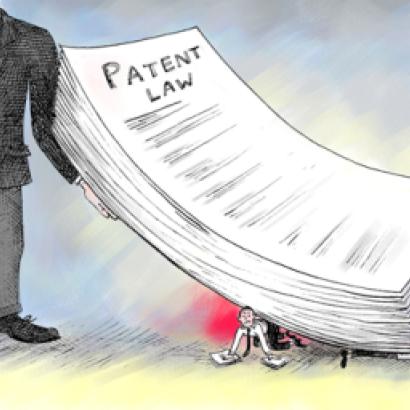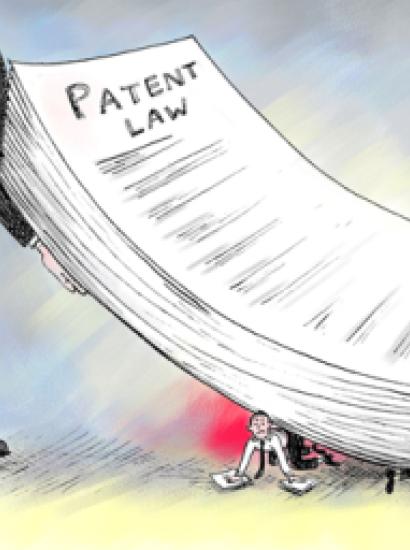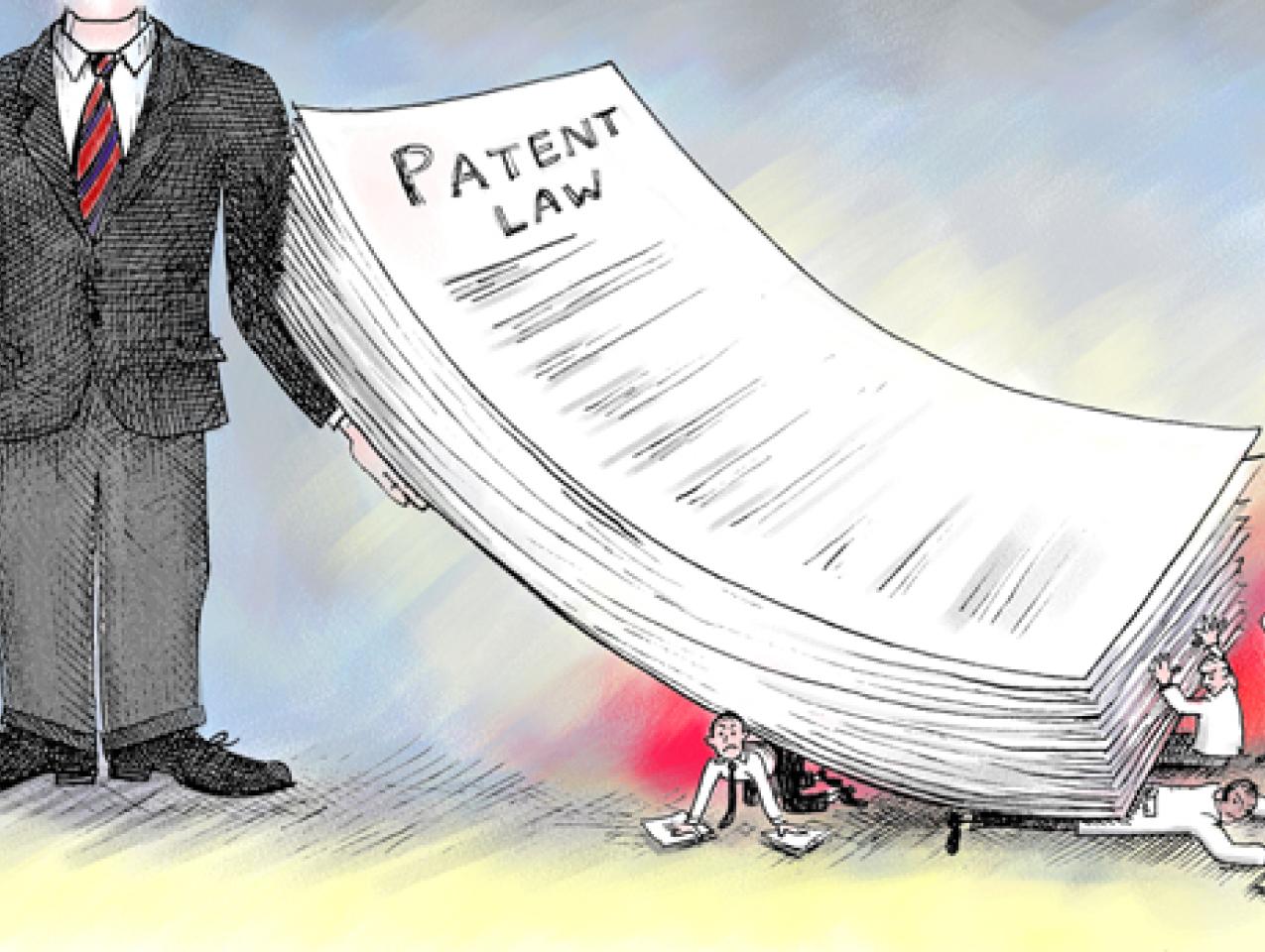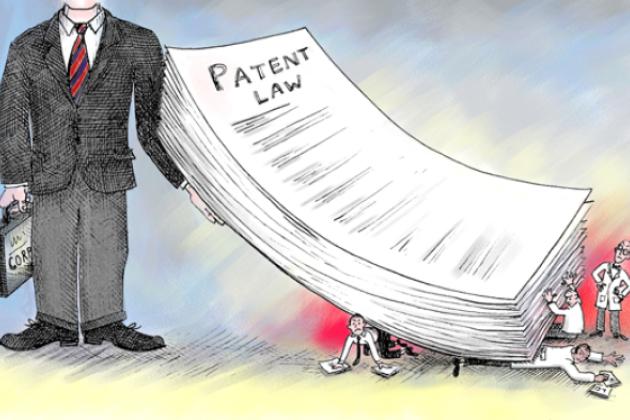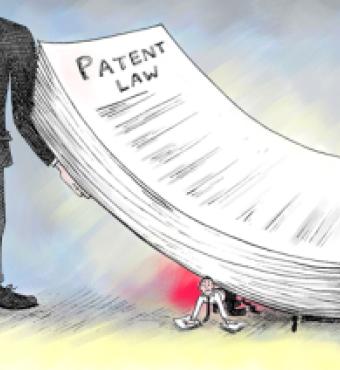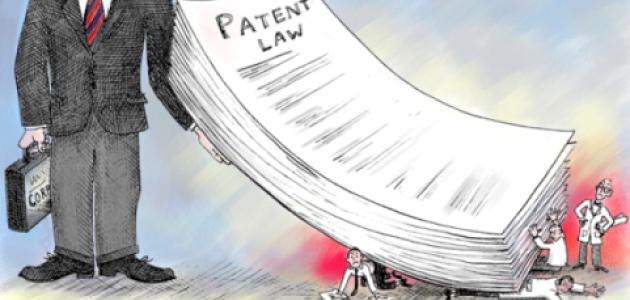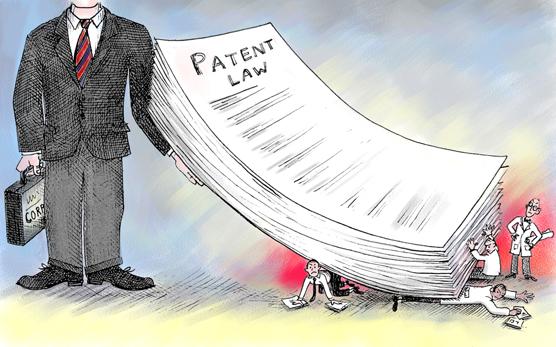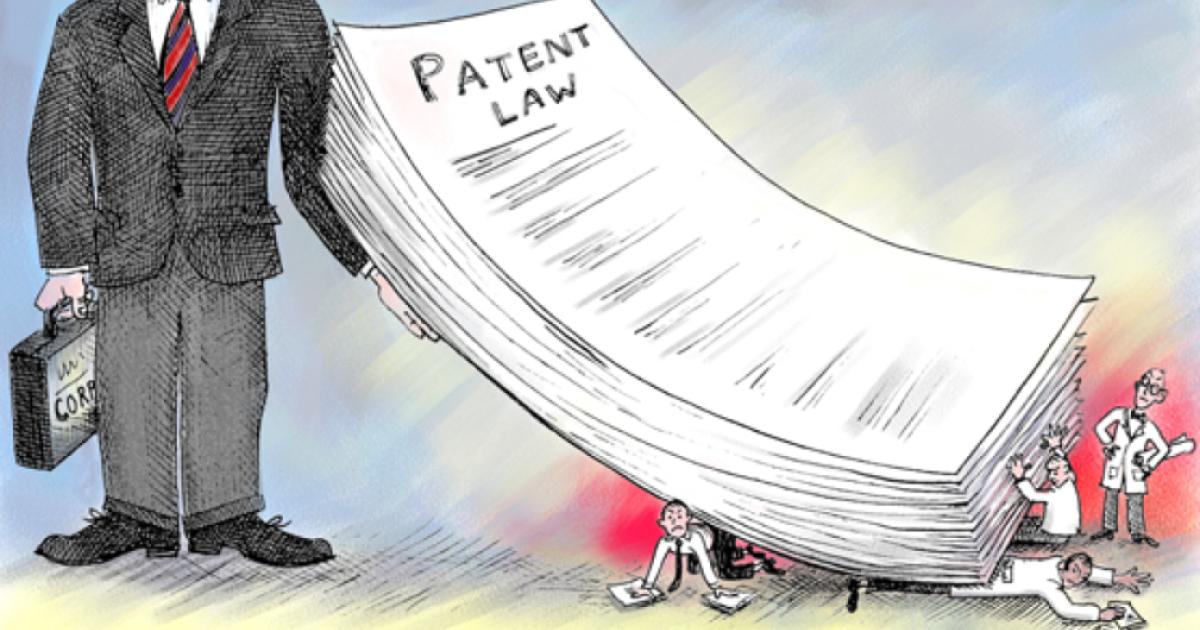- Economics
- Law & Policy
- Politics, Institutions, and Public Opinion
- Regulation & Property Rights
Editor’s note: This is the first installment in a series of four essays by the author on the ongoing efforts in Congress to reform the U.S. patent system. The second essay, "Welcome to Patent Purgatory," can be found here. The third essay, "Patent Reform Goes Haywire," can be found here.The fourth essay, "File First, Invent Later?" can be found here.
In each of its past several sessions, Congress has been hotly debating significant changes to our patent system. Implementation may now be drawing near, with the America Invents Act having passed the full Senate on March 8, 2011, by a vote of 95–5, and a similar version having passed the House Judiciary Committee on April 14, 2011, by a vote of 32-3. But despite significant support from both parties, in both the Senate and the House, there’s still a good chance that the bill will not pass—and it should not.
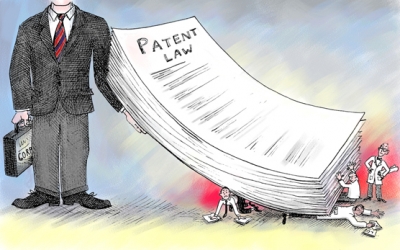
Illustration by Barbara Kelley
Purported to be a tool for streamlining the patent system, the America Invents Act will at best gum up the patent system and at worst turn it into a system for protecting the largest entrenched players at the expense of market challenging competitors. The bill would frustrate the ability for small and medium sized innovators to bring innovations to market, and block the opportunities they would create for capital formation and jobs.
An Unfounded Call to Update
Congress is constantly barraged with calls to update our laws to better deal with the many unanticipated changes that confront our society over time. After all, the power to create patents in the U.S. was established at the nation’s founding, in the Constitution, itself; and the first head of the U.S. patent system was none other than Thomas Jefferson.
But the patent system is one area of law where a call to update is least apt. Every patent lawyer will tell you that the patent law doctrine known as "anticipation" works, by design, to ensure that anticipated technologies are not patentable. Patent law is entirely directed towards those technologies that are unanticipated.
It’s easy, for instance, to envision our nation’s founders sweating out drafting sessions over long summers in Philadelphia’s Independence Hall, with the then-un-anticipatable aid they could have enjoyed from central air-conditioning, or other modern marvels like the Internet, cell phones, airplanes, automobiles, telephones, and television, all of which were brought to market through patents.
Critics of the modern patent system tell countless ghost stories of the fear inflicted on everyone from basic scientists to large corporations by the demon artfully named a patent troll. Yet when asked to precisely define who this ogre is in reality, it often boils down to whoever successfully sued some sympathetic defendant or whoever is presently suing the speaker. While the ever-present threat of patent enforcement is said to be causing immense gridlock in our economy, we are never told what exactly is so precarious about this state of affairs and why some patent lawsuits would disrupt it.
After all, a few airplanes do regrettably crash once in a while and yet the airline sector still does business. And while driving has many benefits over flying, data do not support the idea that travel safety is one of them. That’s why serious policy makers looking for sound basis for making a policy shift to improve overall travel safety don’t point to the many people who invoke flight safety as their reason for electing to drive over taking commercial flights.
The America Invents Act will protect large, entrenched companies at the expense of market challenging competitors.
Indeed, each of those just recited modern marvels of technology—jncluding the airplane—was rich with patents. Some of those patents were basic, broad, blocking patents, and many were narrower, downstream patents, too. Consider just one of the inconvenient truths facing advocates of the features in the present bill designed to shift our patent system towards one that awards patents based on who was the first to file the patent application rather than first to invent the technology. There was a lengthy court battle fought over the initial patent rights in the telephone and only one of the sides in it was expert in the underlying technology and had the now familiar name of Bell. The other side looked in most respects like the demonized patent trolls regularly trotted out by proponents of the present bill.
Predictable Patents Bring Commercialization and Competition
Stylized talking point memos in debates about patents often cartoon each other. Some say that strengthening patents will bring a flood of patent lawsuits, grinding to a halt the wheels of future commerce. And others say that weakening patents will make them so worthless that nobody will bother to get them except to hang on a vanity wall next to graduation diplomas.
But this is just the result of the ordinary drive by spin-doctors and masters of messaging on K Street and Madison Avenue to get sound-bite clarity. And that kind of clarity happens to starve the public debate of the hard complex analysis needed to make a well-reasoned choice about how things are likely to play out in reality.
Changes of the type that are the focus of modern debates about patent reform won’t lead to either of these caricature outcomes. They won’t lead to a big increase or decrease in rates of invention, or even patenting. In fact, it’s notable that many of the loudest critics of strong patents are some very large companies, like IBM, which are famously associated with massive portfolios of patents.
Nor will such changes lead to a big shift in the ability for large established firms to do business successfully. Big business can pick up some easy short-term tactical benefits from the changes they are urging as well as some serious long-term strategic opportunities. The changes they propose will lead to subtle but important shifts in the commercialization of new technologies and the overall competitive landscape. But it is exactly those shifts that are both privately good for only these large established players and at the same time socially bad for our overall markets and innovation ecosystem.
Recent history has given us at least two striking natural experiments about how this works. One tells the story of the presence of patents as a key to increased competition and commercialization. The other tells the story of the absence of patents as a key to monopoly.
In the software industry, the absence of patents led to the development of a monopoly.
Before 1980, the U.S., Europe, and Japan all had slid into the view that patents in the area of basic biotechnology were somehow against a range of vaguely defined so-called "public policy" notions. As a result, patents on basic biologicals were not reliably available or enforced. Patents on pharmaceuticals were. Then, thanks to the 1980 Supreme Court Chakrabarty decision, basic biologicals suddenly got to enjoy meaningful patent protection for both products as well as testing methods and devices; but this was only in the U.S., and only after that 1980 change in the case law. The result was remarkable: only in the U.S. was there a drastic increase in the number of small and medium-sized biotechnology companies and a drastic increase in the number of new drugs and new medical devices brought to market.
All of this happened while the steadily growing worldwide success of big pharmaceutical firms persisted, as did rates of invention. And all this happened despite worldwide access to capital and relevant technical skills and know-how.
The software industry offers a similar story from the other side of the coin, where the absence of patents was linked with the development of a monopoly. The U.S. courts had allowed themselves to slide into the view that patents on computer software and methods of doing business were similarly against a range of vaguely defined so-called "public policy" notions from 1972 Supreme Court Benson decision up through the 1980’s and into the 1990’s. That’s when we got Microsoft. And it was only after the 1994 appellate court Alappat decision that the single biggest Microsoft competitor—Google—was able to come to market in the U.S., relying on strong patents and trade secrets.
Odd Political Bedfellows
Both sides of today’s debates about patent reform have some odd bedfellows. Those focusing on the importance of strong patents have included unions, many Republicans, small businesses, and some large pharmaceutical companies. Those focusing on the problems of over-enforcement of patents have been many Democrats joined by a number of big businesses from the high technology sector including Microsoft, Google, IBM, and Cisco, as well as some other large pharmaceutical companies. Similarly, in many of the recent Supreme Court patent cases, some of the most vocal patent critics have included Justice Scalia, a Republican appointee, as well as Justice Breyer, a Democratic appointee.
But debates in this area have long been a mismatch for the typical left/right and Democratic/Republican divides. Our present patent system remains largely based on the 1952 Patent Act, which was strongly endorsed by leading jurists from all sides of the political aisle including Giles Rich who was an Eisenhower appointee, Learned Hand who is generally viewed as a centrist, and Jerome Frank who is generally viewed as a populist.
Similarly, the creation of the U.S. Court of Appeals as a court to strengthen the patent system in 1980 was a major domestic policy initiative of President Carter, a Democrat, and was signed into law with much fanfare by President Reagan, a Republican. And in the recent Supreme Court eBay decision, the voices that spoke out in favor of strong patents included Chief Justice Roberts, a Republican appointee, as well as Justice Ginsburg, a Democratic appointee.
Patents Can Lead to Both Good and Bad Market Coordination
Those who pushed the 1952 Patent Act urged us to focus not only on the way that patents can provide incentives to invent, but also on the way they can help get inventions put to use after the invention is made. Getting inventions put to use, or commercialized, requires coordination among complementary users of the invention, such as investors, managers, marketers, laborers, owners of other inventions, etc. When patents facilitate this good coordination they help new companies compete by providing them with the metaphorical slingshots they need to take on larger established Goliaths. That’s how patents can be both powerful anti-monopoly weapons and essential tools for bringing new inventions into the hands of consumers.
Patents play this good coordination function only when everyone in the market thinks they can be enforced. Predictable enforcement lets patents stand like beacons in a dark room, drawing to them all those who are interested in the technology and in finding others with the same interest. It also encourages these many complementary users of the invention to enter into the complex contracts with each other that are needed to commercialize the underlying invention.
When patents facilitate good market coordination, they foster competition and innovation.
Everyone in those conversations brings to the table a set of assets—such as labor, lab space, personal connections, and so forth. The complex contracts they elect to strike with each other allow them value those contributions however they want to up front. That’s why these patent contracts usually take many pages of single spaced text. If they were only about money they’d be a single sentence, having the patent number, the dollar amount, and, perhaps to facilitate goodwill, a clause agreeing to wish each other a nice day.
Today’s patent critics say they aren’t against remedies for patent infringement, but complain that damages in patent cases are just too high. But the reality is that every one of the cases held up as emblematic of excessive patent damages is one in which the patent at issue was found to have been actually valid, actually infringed, and often the infringement was found to have been willful, which means without any good reason for thinking the patent was not valid and infringed.
The key advantage of having courts enforce patents with damages awards that take into account the particular subjective interests of each of the parties involved in the patents and related contracts is that it encourages these parties to either enter into these contracts or avoid infringement, such as by designing around the patent. This saves courts from having to trace the values of all of the many complementary inputs to the process of commercializing the invention. Instead, it encourages parties to make their own best efforts at negotiating for contractual mechanisms to get at this value up front.
But weak enforcement of patents is bad not only because it undermines this good form of coordination. It also is bad because it facilitates a bad form of coordination.
The techniques for weakening patents that are proposed in the present bill are several, and quite complex. They include: new procedures for continually challenging a patent’s validity; new rules on what counts as prior art against a patent; special preferences for certain categories of patents, like those favoring "green tech"; and special treatment for patents on methods that do business to further challenge their validity, even after they have been tested in court.
One form of bad coordination is among two or more large established players in a market. Consider how such large players might like to talk directly to each other. Doing so raises two key problems for them: trust and antitrust. But if they each have large numbers of patents and know that all patents will be only weakly enforceable in court, then they may be able to significantly mitigate both of their problems.
For example, if two large companies find themselves against each other in a number of patent litigations, then decisions to push hard on some battle lines while yielding on others will be more credible in this venue than during direct conversations when it comes to foundational topics like which parts of the overall market space each company really wants for itself and which parts it can cede to the other. Meanwhile the terabytes of data and countless sworn depositions they swap during litigation only increases the bandwidth and fidelity of the communication channels provided by these patent suits. And then, when they resolve all of these lawsuits, mostly of course by settlement, they will have done so in front of federal judges, tried and true, which essentially eliminates the intent element needed to prove any criminal antitrust action. So if antitrust regulators do ask them to rejigger any of the deals they have struck, the executives won’t face jail time and their shareholders won’t face treble damages. At the same time, because all patents can only be weakly enforced, both of these large coordinating players can rest assured that no David will show up to meaningfully threaten a Goliath.
It’s no wonder so many large established market players are unified behind today’s bill. But what’s good for big business is often not good for business overall. That’s why we should focus on time tested good ideas and practical problem solving, not compromise among loudest voices.
At this point, you might be wondering what exactly is so bad about the patent reforms proposed in the America Invents Act? Several of the act’s biggest problems are explored in some detail in our next three installments.








